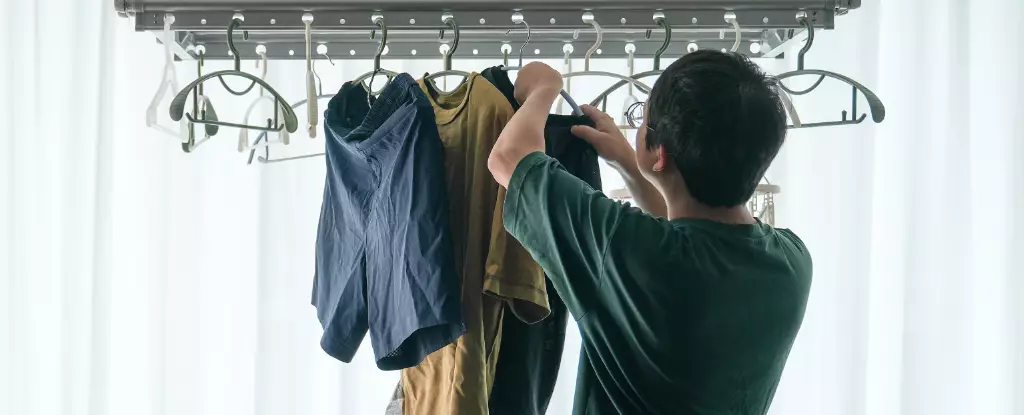As winters become increasingly severe, punctuated by howling winds and biting cold, the familiar sight of clothes fluttering in the breeze is becoming all but nonexistent. With many opting for the warmth and convenience of indoor drying racks, it raises a crucial question: are we compromising our health in the process? While the comfort of indoor clothes drying may seem harmless, the implications of poor ventilation and excessive moisture can lead to dire consequences—most notably, mold growth, which can pose significant health risks to residents.
The Mold Menace: Understanding Fungi and Their Impact
Mold, a type of fungus, is often considered an innocuous part of nature. However, indoors, it has the potential to become a grave concern. Mold reproduces through tiny spores, thriving in conditions typical of damp environments—high humidity combined with cooler temperatures. It’s in these settings, like bathrooms and unventilated laundry rooms, that the danger lurks. Mold varieties such as Penicillium and Aspergillus are common culprits in home infestations, producing distinctive black or green patches on walls and an unmistakable musty odor that signals their presence.
While most individuals can handle occasional exposure to mold spores thanks to a capable immune system, certain populations, particularly those with compromised immunities, face severe health threats. Conditions like asthma and chronic obstructive pulmonary disease (COPD) can be exacerbated by mold exposure, leading to increased symptoms and heightened risks.
The Health Risks and Vulnerable Populations
The relationship between mold and health is complex. For people with robust immune systems, the occasional inhalation of mold spores may not lead to adverse effects; however, the same cannot be said for individuals with compromised immune responses. For those suffering from conditions such as asthma, exposure to mold spores can trigger severe respiratory issues, inflaming airways, and making it increasingly difficult to breathe.
In particularly extreme cases, invasive molds can encroach on the airways, causing catastrophic blockages and potential lung bleeding as the mold forms mycelium—a tangled network of fungal filaments. The urgency for antifungal treatments such as azoles becomes paramount in these instances. However, rising instances of drug resistance raise significant concern, as pathogens evolve faster than our ability to combat them.
Fungal infections are a growing challenge in both agricultural and healthcare settings. The misuse of azole-based antifungals in farming has inadvertently contributed to environmental resistance, rendering these treatments less effective when utilized in clinical settings. Recent studies reveal how certain mold species are becoming adept at surviving in human body temperatures—a development that further complicates the mold infection landscape.
Climate change, too, plays an unexpected role in this unfolding crisis. As temperatures rise, molds are providing evidence of accelerated resistance to antifungal medications, suggesting an urgent need for research and adaptive healthcare initiatives that remain one step ahead of these evolving threats.
The tragic death of young Awaab Ishak underscores the ramifications of neglecting mold in living environments. His demise, due to overwhelming exposure to fungal spores in his home, catalyzed policy reform within UK housing laws. Awaab’s Law now mandates more proactive measures from landlords to address dampness, thereby safeguarding tenants from hazardous living conditions. This incident illuminates the importance of vigilance when it comes to damp and mold, particularly in homes where children or immunocompromised individuals reside.
Preventing Mold Growth: Effective Strategies for Indoor Drying
Prevention is key in avoiding the health risks associated with mold growth. To ensure a safe indoor environment, good ventilation is crucial. Simple actions, such as opening windows or using exhaust fans during and after drying clothes, can significantly mitigate moisture levels. Investing in tools like dehumidifiers or heated drying racks can also make a substantial difference during colder months. These measures not only decrease humidity but also promote faster drying times, reducing the potential for mold to flourish.
As indoor drying becomes a more common practice amid changing climate conditions, we must remain vigilant regarding the unseen health risks it poses. Mold, while a natural phenomenon, can have devastating impacts on health—particularly for the vulnerable. By ensuring proper ventilation, actively monitoring for dampness, and taking proactive steps to safeguard against mold growth, we can create healthier homes and mitigate the dangers associated with indoor laundry drying. Awareness and action are essential to protect ourselves and our families from the latent threats that may lie within our living spaces.


Leave a Reply